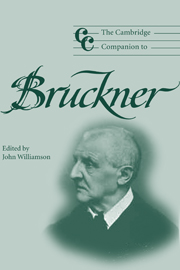3 - Bruckner in Vienna
from Part I - Background
Published online by Cambridge University Press: 28 September 2011
Summary
Historical and social environment
The imperial capital and residence of Vienna, the central melting pot of The Habsburg monarchy's empire of four million people, contained roughly 600,000 inhabitants at the end of the 1860s and had spread far beyond its old city walls. New architecture quickly determined the city's image. The entire city was a building site: in 1857 the Emperor Franz Joseph I had ordered the razing of the fortifications and in their place the new Ringstrasse emerged with its official buildings and various palaces of the grand bourgeoisie.
Even if Austria's power had declined in 1866 because of its defeat by Prussia, the liberal constitution of 1867 still led to the equality of all citizens. The loosening of the phase of political Restoration as well as Liberalism brought a general commercial upswing followed by a long stagnation after the stock market crash of 1873. The subsequent downfall of Liberalism led in the final decades of the century to the rise of anti-capitalism and anti-Semitism. The Taaffe government's swing away from Liberalism in 1879 led To increased political activity and socio-religious ferment. The strong growth of population and the doubling of the inhabitants up to 1890 revealed new problems in a great city, as also intermittently did problems of nationality through the immigration of essential labour.
- Type
- Chapter
- Information
- The Cambridge Companion to Bruckner , pp. 26 - 38Publisher: Cambridge University PressPrint publication year: 2004
- 4
- Cited by



